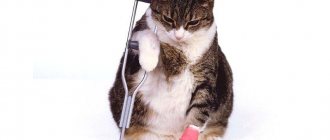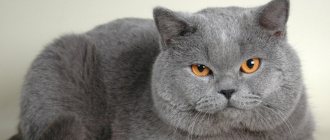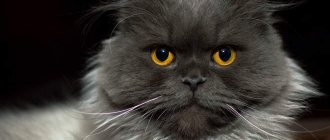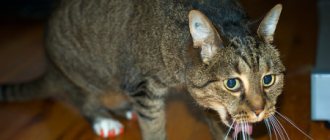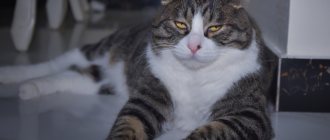When faced with arthritis or arthrosis, cats begin to experience severe pain and stiffness when moving, lifting and jumping even to low heights. These diseases cannot be neglected - they can lead to irreversible consequences. What are the symptoms of arthritis and arthrosis in cats? What is the treatment? Find answers to these and other questions below.
Read in this article:
What is this? At-risk groups
Causes of arthritis and arthrosis
Symptoms of joint damage
Diagnosis of the condition
Treatment of arthritis and arthrosis
Treatment of lameness in cats
When you have decided on the causes of lameness in the front paw, it’s time to start treatment. It can be simple and done at home with the help of medications, for example for a minor sprain or dislocation. More serious illnesses are treated in a hospital, and surgical intervention is possible.
Drug therapy
In the case where lameness is associated with a splinter or other foreign body getting into the paw, treatment consists of treating the wound with a simple antiseptic. But first the splinter is pulled out so that swelling and inflammation do not occur. As a rule, no complications arise, the wound heals within 2-3 days. Along with painful sensations, lameness will disappear. Fractures are not uncommon in active cats. If the animal breaks its paw, you should try to immobilize it before arriving at the clinic. At the hospital, the cat will be examined and a bandage or cast will be applied.
Treatment of degenerative changes in the limbs and arthritis in cats is carried out with the help of drugs that restore the elasticity of cartilage, for example, Ketofen. It is prescribed both in tablet form (1 tablet once a day) and in the form of injections (1% solution). Medicines can only be prescribed by a veterinarian, after carrying out the necessary diagnostic measures. If pathological changes in the joints are caused by excess weight and impaired metabolism, the animal is prescribed a diet to reduce body weight.
There are cases. When it is impossible to determine the exact cause of lameness. In this case, the animal is prescribed to minimize physical activity and is prescribed anti-inflammatory drugs. Painful sensations are relieved by No-shpa, Papaverine, etc.
If lameness is caused by an infectious disease, then the root cause is eliminated first. Diseases like calcivirosis are treated with broad-spectrum antibiotics in combination with immunostimulants, anti-inflammatory drugs and vitamins. This is necessary to protect the animal’s body, which is already weakened by the disease. The doctor may prescribe a weekly course of Flemoxin at a dosage of 12.5 -22 mg per kilogram of weight.
Front paw fracture in a kitten
Surgical intervention
The duration and intensity of treatment depend on the type of disease and its advanced stage. For example, osteomyelitis disappears with age, but osteochondrosis, arthritis and arthrosis can become chronic. In this case, constant dulling of painful outbreaks with anti-inflammatory and painkillers will be required.
When lameness becomes severe, surgery is required. Depending on the situation, the doctor may decide to replace the affected joint with a prosthesis.
If the kneecap is dislocated, if timely treatment is not carried out and the disease progresses to stages 3 and 4, surgery is prescribed. The same applies to osteochondrosis. At the beginning of the development of the disease, medications are prescribed. If the lameness does not go away, but only progresses, surgery will be prescribed to eliminate the pinched nerve.
Forms of the disease
According to the duration and severity of the course, acute, subacute or chronic forms of the disease are distinguished.
In acute cases, inflammation is accompanied by the formation of serous exudate. The process can be complicated by the loss of fibrinous sediment or purulent inflammation spreading to adjacent tissues and muscles.
Chronic arthritis, occurring for quite a long time with periodic relapses, leads to the growth of the lining of the inner surface of the joints and granulation of the cartilaginous surface. This is fraught with the development of deformities and contractures of the joints.
Diseases of the joints and bones
Diseases that affect a cat's joints are often age-related and occur after 6-8 years of life. Some pathologies are congenital and develop gradually; more than a month may pass before the first symptoms appear. Viral diseases and various infections often serve as the impetus for the development of inflammation of joint tissues. If a cat has lameness, the following diseases are possible:
- Hip dysplasia. A genetic abnormality that an animal suffers from birth or has a predisposition to develop. It progresses even at a young age. Lameness in an animal is most noticeable after sleep or rest. When a pet “develops” its limbs after a long period of rest, the symptom is not very pronounced or becomes almost invisible.
- Arthritis and arthrosis. These diseases in most cases occur in older cats and are the most common pathologies affecting the joints. Changes in tissues in both diseases are largely similar, as are the symptoms of their manifestation. The animal tries to move as little as possible - this way the pain practically goes away. The cat refuses to eat and becomes weaker, and sometimes there is a rise in body temperature. Swelling occurs in the joint area, the animal reacts aggressively to palpation, and a local increase in body temperature is felt.
- Patella or luxating kneecap. The pathology is rare and is caused by genetic abnormalities or severe trauma. The disease manifests itself abruptly: the animal suddenly begins to limp, it experiences severe pain, to which the cat reacts by meowing and hissing. Treatment is required as soon as possible, since with further development of the disease, surgical intervention will become necessary.
- Osteomyelitis. The disease most often occurs in cats at a young age during the period of active growth. It is characterized by the process of degeneration of bone tissue and its partial destruction, affecting both one limb and several at once. The disease causes severe pain, so the pet does not allow the affected paws to be touched.
- Osteochondrosis. A disease of the spine, as a result of which the spinal roots are pinched or pinched, causing the cat to lame in various limbs. A failure in the formation of cartilage tissue leads to the abrasion of the cartilage layer between the vertebrae, which causes severe pain when moving. A cat sometimes not only limps on its hind leg, but also pulls it back.
- Osteosarcoma. A malignant formation that occurs in bone tissue. Most often it affects animals over the age of 6 years.
All these diseases are serious and require timely treatment under the supervision of a specialist. Typically therapy consists of painkillers and corticosteroids. In severe cases, surgery is required. If you suspect that your cat is limping due to any of the listed joint diseases, you should immediately contact a veterinary clinic. At home, you can only waste time without proper treatment.
Clinical symptoms
Unfortunately, owners notice signs of osteochondrodysplasia in their pet only when they become pronounced. Main clinical symptoms of the disease:
- lameness;
- head too big;
- crooked teeth;
- stiff gait;
- jaw protruding forward;
- excessively short and flattened nose;
- the appearance of growths on the paws;
- refusal to move and jump;
- the tail is too short and inactive;
- pain during movement;
- twisted and shortened limbs;
- walking on bent legs.
- The base of the tail is too thin.
Important! Osteochondrodysplasia of Scottish Fold cats most often appears at the age of 1.5–2 months. If the gait of a small Scottish Fold is stiff and the tail is motionless, then the kitten is not recommended for purchase.
Prevention of lameness
Some cats, due to their natural predisposition, may suffer from lameness. Proper maintenance of the cat can avoid its occurrence or at least reduce the intensity of its manifestations: protect it from injury, adjust the diet, adding more foods with calcium and vitamins.
If you want to know whether a kitten will limp in the future, study its pedigree. Perhaps this is due to heredity and does not pose a danger to the health and life of the animal.
Cats that have crossed the border of old age, as a rule, move little and therefore begin to limp due to atrophy of the limbs. Play with them more often, provoking them to take active actions.
To prevent splinters from getting into your paws, do not be lazy to clean the room as thoroughly as possible, making sure that there are no objects lying on the floor that are potentially dangerous to the animal.
Lameness in cats is not that uncommon. If nothing else bothers your pet except it, then it is quite possible that in a couple of days the situation will return to normal. If you see that the cat has become restless and has been limping for a long time, then professional help is required.
Do straight-eared Scottish cats get sick?
Owners of the straight-eared variety of Scottish cats do not have to worry about the fact that their pets may develop osteochondrodysplasia. Scottish Straights are not susceptible to this disease, because their ears are not deformed, which means they do not have the gene for lop ears. In very rare cases, Scottish Straight cats may also experience deformation of the musculoskeletal system, but this is usually minor. This is because the Scottish cat breed is prone to various bone and joint problems.
Interesting! In addition to the Scots, representatives of the Ukrainian Levkoy breed are also susceptible to osteochondrodysplasia, since Scottish Folds were used to breed them.
Owners of Scottish Fold cats who have been diagnosed with osteochondrodysplasia should not despair. After all, with timely treatment, proper care, supportive therapy, as well as love and care from the owner, the pet can live a long and happy life.
